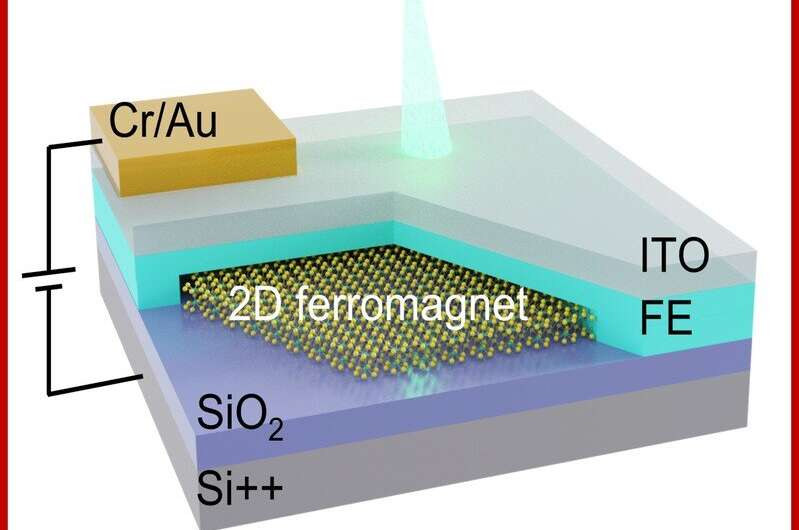April 17, 2023 feature
This article has been reviewed according to Science X's editorial process and policies. Editors have highlighted the following attributes while ensuring the content's credibility:
fact-checked
peer-reviewed publication
trusted source
proofread
Study demonstrates the non-volatile electrical control of a 2D magnetic insulator using a thin ferroelectric polymer

Two-dimensional (2D) magnetic insulators, which are electrically insulating materials with long-range magnetic order, could be used to fabricate compact magneto-electric or magneto-optical devices. Efficiently and reliably controlling the properties of these atomically thin magnets through electrical means, however, has so far proved to be highly challenging, as the materials' charge levels often cannot be largely adjusted and their crystal fields cannot be considerably altered using external electric fields.
Researchers at University of Maryland and their collaborators recently devised a new strategy that could be used to efficiently control 2D magnetic insulators. This strategy, outlined in a paper in Nature Electronics, relies on the use of a thin ferroelectric polymer that can modulate the 2D materials' magnetic responses.
"When it comes to electronic devices, people are primarily pursuing a smaller form factor (relating to higher integration density, which means more devices can be integrated on the unit area/volume of a chip), lower energy consumption, and higher performance," Cheng Gong, the lead principal investigator for the study, told Tech Xplore.
"2D materials are atomically thin, so they naturally have advantages in terms of small form factors. If we can use small voltages to control the magnetic states, that implies low energy consumption. And if such control can be nonvolatile, that would be great for memory devices (i.e., after turning off the electrical power, information can remain in the memory without disappearing)."
A key goal of the recent work by Gong and his colleagues was to explore the possibility that ferroelectric thin films could be used to control the properties of 2D magnets in a non-volatile manner. Given that such films are thin and can be modulated in a non-volatile way by applying a small voltage to them, the team hoped that they would enable the low-voltage, non-volatile control of atomically thin 2D magnetic insulators.
To test this hypothesis, they essentially placed a ferroelectric thin film on top of a 2D magnet flake and then applied a voltage to it. In their experiments, they specifically used the 2D magnetic insulator chromium germanium telluride (Cr2Ge2Te6) and the ferroelectric polymer P(VDF-TrFE).
"Ferroelectric materials are those materials with intrinsic electric dipoles," Gong explained. "The positive and negative charges do not center at the same position in ferroelectric materials, so an electric dipole will be established between positive charge and negative charge. Once small voltages of opposite signs are applied, the positions of positive and negative charges can be switched back and forth. The two ferroelectric configurations can affect the properties of 2D magnets differently."
Initial tests carried out by this team of researchers yielded very promising results, as their proposed strategy enabled the ferroelectric control of a 2D magnetic insulator via the application of a small (5V) electrical voltage. The 2D magnet they used is a ferro-magnet, while the polymer they used is ferro-electric; thus, they ultimately produced what they refer to as a multi-ferroic system.
Gong and his colleagues were the first team worldwide to demonstrate the non-volatile electrical control of 2D magnets. In the future, the new strategy they introduced could inform the development of new energy-efficient spintronic memories and logic devices.
"There are many fundamental physical processes underlying these materials' structures and also a lot of room to further advance the resulting device's performance," Gong added. "By introducing these devices into other fields of study, we could achieve interdisciplinary developments leading to the creation of disruptive devices, such as biosensors for the early detection of diseases, or food sensors for spoilage/freshness monitoring."
More information: Shanchuan Liang et al, Small-voltage multiferroic control of two-dimensional magnetic insulators, Nature Electronics (2023). DOI: 10.1038/s41928-023-00931-1
© 2023 Science X Network





















